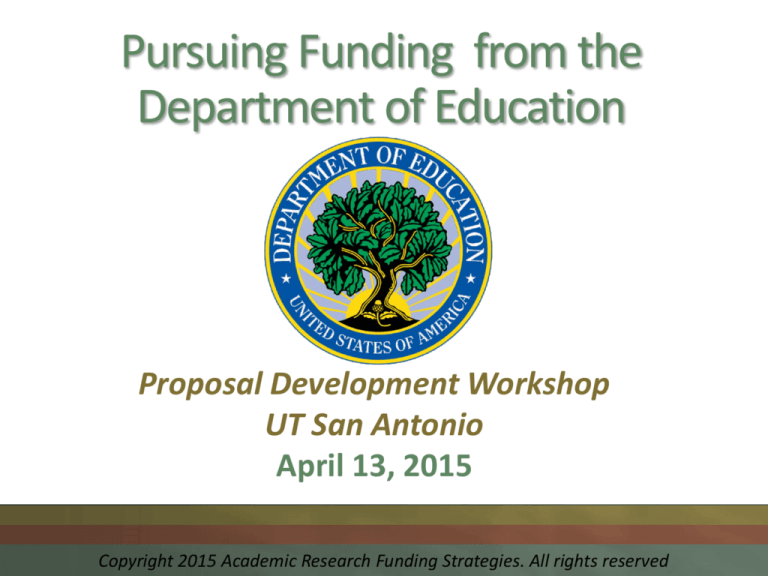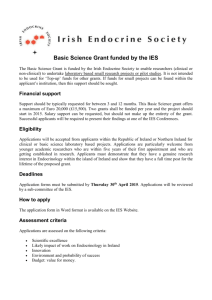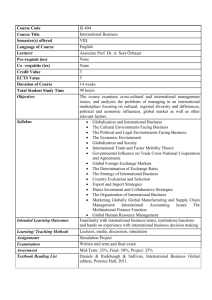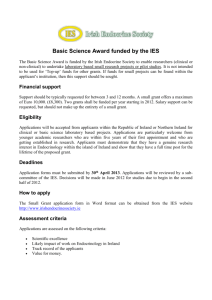
Pursuing Funding from the
Department of Education
Proposal Development Workshop
UT San Antonio
April 13, 2015
Copyright 2015 Academic Research Funding Strategies. All rights reserved
Your CD/memory stick contains
These slides
Handouts (one pdf file)
Additional resources
Articles
These files can be downloaded from
http://1drv.ms/1awRaTL
Academic Research Funding Strategies, LLC
Our goal:
To help your institution, faculty and staff to
develop the skills they need to compete
successfully for research funding.
http://academicresearchgrants.com
3
Lucy Deckard
Ldeckard@academicresearchgrants.com
979-693-0825
Founder and President, Academic Research Funding
Strategies, LLC (2010)
Nine years in research and proposal development at Texas
A&M University as associate director of two research
development and grant writing offices
BS/MS Materials Science and Engineering
Junior Faculty Initiative, CAREER, instrumentation, research,
education, Center-level proposals
NSF, NIH, DOE, DoD, DoED, IMLS, Foundations
Research Engineer (16 years in applied research, with
extensive proposal writing experience to NSF, DARPA, ONR,
AFOSR, ARO, DOE)
4
Examples of Education Funders
U.S. Department of Education (ED)
National Science Foundation
Institute of Education Sciences (ED/IES)
National Center for Education Research (IES/NCER)
Texas Education Agency
National Science Foundation
William T. Grant Foundation
Spencer Foundation
Arthur Vining Davis Foundations
Russell Sage Foundation
Alfred P. Sloan Foundation
Ford Foundation
Foundations for Education Excellence (Foundation Center)
More
5
Grant Rule #1:
Get to Know Your Potential Funder!
6
Steps to pursuing discretionary funding
from ED
Understand ED’s mission and culture
Know where new ED solicitations are posted
Analyze the ED solicitation in detail
Understand the ED application process
Understand the role of ED program officers
Learn how your ED proposal will be reviewed
Learn how the ED funding decision will be
made
7
U. S. Department of Education (ED)
ED offers three kinds of grants:
Discretionary grants: awarded using a
competitive process and peer review—
the focus of this presentation.
Student loans or grants: to help students
attend college.
Formula grants: uses formulas
determined by Congress and has no
application process.
8
ED discretionary grants
Use a competitive review process rather than a pre-existing
formula.
Most university faculty or other university eligible PIs will
respond to discretionary grant programs at ED (more).
Eight principal offices administer the discretionary grant
programs. For example:
Office of Postsecondary Education (OPE) formulates federal
postsecondary education policy and administers programs
that address critical national needs in support of
postsecondary education through 2 programs
Higher Education Programs (HEP)
International and Foreign Language Education (IFLE).
9
Offices Administering Programs
Federal Student Aid (FSA)
Institute of Education Sciences (IES)
Office of Elementary and Secondary Education (OESE)
Office of English Language Acquisition (OELA)
Office of Innovation and Improvement (OII)
Office of Postsecondary Education (OPE)
Office of Safe and Drug Free Schools (OSDFS)
Office of Special Education and Rehabilitative Services
(OSERS)
Office of the Deputy Secretary (ODS)
Office of Vocational and Adult Education (OVAE).
Multiple Paths to ED funding
ED grants forecast: competitions opening soon
Grants.gov: Application packages for ED
programs
Federal Register Notices: competitions and
other ED announcements
Open ED competitions: with links to application
information
IES funding: funding opportunities from ED's
Institute for Education Sciences (IES)
A-Z list of all ED programs
1
1
Understanding ED Programs
Grantmaking at ED
general overview of the grant process
non-technical summary of ED's discretionary grant
process.
Guide to Education Programs
annual publication
Info on financial assistance offered to
state and local education agencies
institutions of higher education
other postsecondary institutions,
public and private nonprofit organizations
individuals
1
2
Discretionary Grants Advice
ED publication Answers to Your Questions About
the Discretionary Grants Process, 2010,
69-page overview of the discretionary grants process for new
and experienced grant seekers
(formerly called “What Should I Know about ED Grants”).
Grantmaking at ED: Answers to Your Questions
About the Discretionary Grants Process (new
website under construction)
13
Office of Postsecondary Education
Link to programs
Institutional Service Programs
International and Foreign Language Education
Student Service
Other programs (miscellaneous)
Example: Hays-Fulbright Group Projects Abroad
1
5
16
1
7
18
1
9
2
0
21
22
23
2
4
2
5
2
6
Evaluation Plan – 20 points
2
7
2
8
Institute for Education Research (IES)
Research arm of ED
Mission: Provide rigorous and relevant evidence
on which to ground education practice and
policy and to share information broadly
Identify what works, what doesn’t, and why
Improve educational outcomes for all students,
particularly those at risk of failure
Approach: Conducts and supports rigorous
education research, statistics, and evaluation to
provide reliable information about education
IES Research Priorities
IES supports projects to
Examine the state of education in the US
Develop and evaluate innovative approaches to improving
education outcomes
Understand the characteristics of high-quality teaching
and how better to train current and prospective teachers
and how to recruit, support and retain effective teachers
Understand classroom, school, and other social contextual
factors that moderate the effects of education practices
and contribute to their successful implementation and
sustainability
IES Supports
Education and Special Education Research
Programs
Research Training Programs
Statistical and Research Methodology in
Education
Partnerships and Collaborations Focused on
Problems of Practice or Policy
National Research and Development Centers
and Special Education Research and
Development Centers
IES Funding Opportunities
National Center for Education Research (NCER) administers 10
long-term education research programs
Cognition and Student Learning
Early Learning Programs and Policies
Education Technology
Effective Teachers and Effective Teaching
English Learners
Improving Education Systems
Mathematics and Science Education
Postsecondary and Adult Education
Reading and Writing
Social and Behavioral Context for Academic Learning
Last year’s deadlines
June 2014 letter of intent
August 7, 2015 application due date
Other initiatives – May come and go with various due dates
Note: funding fluctuates from year to year, affecting grant competitions
IES Funding Opportunities
National Center for Special Education Research (NCSER)
administers 11 long-term special education research programs
Early Intervention and Early Learning in Special Education
Reading, Writing, and Language Development
Mathematics and Science Education
Social and Behavioral Outcomes to Support Learning
Transition Outcomes for Special Education Secondary
Students
Cognition and Student Learning in Special Education
Professional Development for Teachers and Related
Service Providers
Special Education Policy, Finance, and Systems
Autism Spectrum Disorders
Technology for Special Education
Families of Children with Disabilities
Types of Project (Goals)
Exploration – Explore the relations between education outcomes and
malleable factors, as well as mediators or moderators of those relations.
Intended to inform development of interventions. Typical $100K - $300K per
year, up to 2 years
Development & Innovation – Develop innovative education interventions
(programs, practices, technology, policies) or improve existing education
interventions. $150K - $400K per year, up to 3 years
Efficacy & Replication – Experimental and quasi-experimental research
projects to evaluate the efficacy of newly developed and existing education
programs, practices, and policies. Typical $250K - $650K per year, up to 4
years
Scale-up Evaluation – Scale-up evaluation to determine whether or not an
intervention is effective when implemented under conditions of routine
implementation. Typical $250K - $400K per year, up to 3 years
Measurement – Research to develop and validate measurement instruments
that are intended for purposes such as screening, progress monitoring, and
outcome assessments. Typical $150K - $300K per year, up to 4 years
IES Funding Opportunities
IES also supports:
Research Training Programs in Education Sciences and Special
Education (postdoctoral and predoctoral)
Statistical and Research Methodology in Education
Evaluation of State and Local Education Programs and Policies
National Research and Development Centers and Special
Education Research and Development Centers
(not all programs have competitions every year –
watch for RFAs on website and in Federal
Register)
IES Funding Opportunities
Unsolicited (investigator-initiated)
Research, evaluation, statistics, and knowledge utilization
projects that contribute to IES’s mission but are not eligible
for funding under current grant competitions
Or time-sensitive research projects (only these were
accepted for FY 2014)
Discuss with Program Officer
For FY 2014 funding, a 6-page prospectus had to be
submitted before March 4th (see instructions)
Other IES Resources
Research Funding Webinars
Overview of IES Research and Research Training
Grant Programs
Search funded IES grants
Sign up for email notices of funding
announcements, other news
Resources for Researchers
Types of Projects
Basic
Applied
Ideal
Conditions
Routine
Practice
Exploration
Scale-up
Types of Projects (Goals)
Exploration – Up to $700K for up to 2 years (more
for projects with primary data collection)
Development & Innovation – up to up to $1.5M for
up to 4 years
Efficacy & Replication – Up to $3.5M for up to 4
years
Effectiveness – Up to $5M for up to 3 years (3 years
for follow-up)
Measurement –Typical $1.6M per year, up to 4
years
Exploration Projects (Goal 1)
Explore the relations between education outcomes and
malleable factors, as well as mediators or moderators of those
relations.
Intended to inform development of interventions.
Cannot proposal to develop an intervention
Should include:
Description of the malleable factors, the relationships you expect them to
have with specific student education outcomes, and any mediators or
moderators you will be studying.
Theory for and evidence that the malleable factors may be associated
with beneficial student education outcomes or that the mediators and
moderators may influence such an association.
How the results of this work will inform the future development of an
intervention or assessment or the future decision to evaluate an
intervention
Development & Innovation (Goal 2)
Develop innovative education interventions (programs,
practices, technology, policies) or improve existing
education interventions to improve student education
outcomes in education settings.
Should result in a fully developed intervention
Must include:
Detailed plan for development of intervention
Pilot study
Measures, data analysis procedures
Dissemination plan
Efficacy & Replication (Goal 3)
Experimental and quasi-experimental research projects
to evaluate the efficacy of newly developed and
existing education programs, practices, and policies
implemented under ideal or routine conditions.
Expected outcome:
Evidence regarding the impact of a fully-developed intervention on
relevant student education outcomes relative to a comparison condition
using a research design that meets the Institute’s What Works
Clearinghouse evidence standards (with or without reservations)
Conclusions about and revisions to the theory of change guiding the
intervention
Effectiveness (Goal 4)
Scale-up evaluation to determine whether or
not a fully-developed intervention is effective
when implemented under conditions of routine
implementation.
Follow-ups also funded
Measurement (Goal 5)
Research to develop and validate measurement
instruments that are intended for purposes such
as screening, progress monitoring, and outcome
assessments.
IES Research Funding Webinars
The National Center for Special Education Research and
the National Center for Education Research within the
Institute of Education Sciences periodically host a series
of webinars related to research funding opportunities.
Sign up to receive valuable information on choosing the
correct funding opportunity, grant writing, the
application process, and more.
For more information regarding webinar topics, dates,
and registration process, browse here.
To view slides from previous webinar sessions, browse
here.
4
5
4
6
4
7
Before You Start Writing
4
8
Start with your great idea
Translate it into a project
What are your objectives and how will they contribute to
your long-term research goals?
Is the scope appropriate for the funding opportunity and
project type?
Do you have required equipment and resources?
Do you need collaborators (other researchers, schools,
etc.)?
Does the project meet the requirements of a particular
program?
Do you have enough publications and/or preliminary
data related to the topic?
49
Logic Model
From W.K. Kellogg Logic Model Development Guide
50
Theory of Change
From IES Education Research Grants RFA for FY 2015
Formulating Clear Objectives/Aims
Objectives should support your goal(s)
Outcomes should be clear
Often tied to research questions/hypotheses
or theory of change
Avoid ambiguous terminology
Beware too many objectives!
Common Mistakes
Mismatch with funder or program
Too theoretical if funder is looking for applied
research
Outcomes not clear
No clear theory of change and rationale
Insufficient impact or significance
Do not tie clearly to goals
Read and Re-read the RFA
Review criteria
Address these clearly and concisely
Make these easy to find
Proposal components
Don’t forget any components
Page limitations
Formatting requirements
Follow directions religiously!
Example
Talking to the Program Officer
Do your homework first
Read the RFA and background materials carefully
Look at what else has been funded
Develop at the main ideas of your project
Email your program officer with a concise
description of your idea and ask for a time to call
During your call, ask open-ended questions and
listen carefully
Does this project topic fit the interests of your
program?
Which program type should I apply under?
Do you have any suggestions about how to improve it
or pitfalls to avoid?
55
Typical IES Proposal Components
SF-424 Forms
Summary/abstract 1 page
Project Narrative 25 pages single spaced
Appendices
Bibliography and References Cited
Example Project Narrative Requirements
Development and Innovation Project
Significance of Project – why is this important?
Research aims
Context of proposed intervention
Intervention features and components, theory of change, and theoretical and empirical
rationale
Practical importance
Rationale justifying the importance of the proposed research
Research Plan – how will you accomplish your aims?
Methodology
Sample
Iterative development process
Feasibility of implementation
Pilot study
Measures
Personnel – why is your team qualified and likely to
succeed?
Resources – do you have the resources required to
succeed?
Other
Results of previous grants, etc.
Review Criteria
Significance
Does the applicant provide a compelling rationale for the
significance of the project as defined in the Significance of the
Project section for the goal under which the applicant is submitting
the proposal?
Research Plan
Does the applicant meet the requirements described in the
methodological requirements section for the goal under which the
applicant is submitting the proposal?
Personnel
Does the description of the personnel make it apparent that the
Principal Investigator and other key personnel possess appropriate
training and experience and will commit sufficient time to
competently implement the proposed research?
Resources
Does the applicant have the facilities, equipment, supplies, and
other resources required to support the proposed activities? Do the
commitments of each partner show support for the implementation
and success of the project?
How ED Reviews Your Application
Usually recruit application reviewers from outside
who have expertise in the subject area of the grant
program for which the applications were submitted.
For some competitions, program offices may use
employees or contractors of ED, or employees of
other federal agencies, to serve as reviewers.
In general, ED screens applications to ensure that
they meet all the requirements of the program and
assign applications to reviewers.
Reviewers read and independently score each
application assigned to them.
After the reviewers scoring, ED program staff
conduct an internal review to ensure scoring sheets
are correctly completed.
5
9
ED Review Process
Peer reviewers score each application based on review
criteria
Average score determines rank order
Number of applications to be funded are determined
by available appropriations
Cost analysis performed on applications to be
considered for funding
Formal list (“slate”) of applications recommended for
funding created
Principal officer of the program office makes final
decision (may consider other info such as applicant’s
past performance, geographic distribution, etc.)
Other ED funding key factors
No particular score guarantees funding.
Depends on number of high-scoring applications
and geographic distribution
Some applications may not be funded because of
an applicant’s poor performance in the past on
other federal projects.
6
1
Grantsmanship
Things to
Keep in
Mind
It’s not about you…
It’s about the funder
Understand what the funder is trying to
accomplish by giving this grant
Explain how funding you will help them to
accomplish those goals
A Proposal is Not an Academic Article
Must be persuasive
Must communicate passion
Must communicate impact
Must be easy to understand by readers
with various backgrounds
Must tie research to the goals of the funder
Focuses on future, not past
Must inspire confidence in researchers’
abilities and resources
Make Your Proposal Easy to Understand and
Easy to Read
Use figures, flow charts, tables, bullet lists,
etc.
Use heading and subheadings to help
reviewers locate the information
Bold, italics and underlining (used
judiciously) can help reviewers find
important points
No tiny fonts or illegible figure labels
You must convince the reviewers…
This is a project that should be done
It supports the goals of the agency and program
It will yield significant results
It is more important (or cooler or more
significant) than other proposed projects
You (and your team) are the right people
to do it
You have the skills and resources to be successful
You have thought through the project
And most importantly, you must….
Intrigue the Reviewers
Now to the Nitty Gritty…
Writing
The Project Description: Getting Started
Reviewer’s Attention Level
14
12
Get to the
exciting
Concise background
stuff here! Strong,
that provides context
Unique Intro
10
8
Generic Intro
6
4
2
0
Long, unconnected
Zzzzzzz
background
Get to the
exciting stuff
here!
First
Paragraph
Put Your Project in Context
Preliminary Work Funded project 1
Further work
Project Goals/Specific Aims
Outcomes
The Big Question or
The Big Need
What is the kernel of your great idea?
What you will accomplish
The approach you will use
The problem you’re addressing
New tools or resources you’ll bring to the
problem
Put it up front!
Introduction and Overview
Provide reviewers with an outline of your proposed
project which you will fill in later (1 – 2 pages)
72
Tell Your Project Story
The Need/Motivation
Goals
Gaps
New Knowledge
Hypotheses
Research Questions
Approach
Objectives
How it’s Different
Significance
Outcomes
Impact
73
How ED Reviews Your Application
Usually recruit application reviewers from outside
who have expertise in the subject area of the grant
program for which the applications were submitted.
For some competitions, program offices may use
employees or contractors of ED, or employees of
other federal agencies, to serve as reviewers.
In general, ED screens applications to ensure that
they meet all the requirements of the program and
assign applications to reviewers.
Reviewers read and independently score each
application assigned to them.
After the reviewers scoring, ED program staff
conduct an internal review to ensure scoring sheets
are correctly completed.
7
4
ED Review Process
Peer reviewers score each application based on review
criteria
Average score determines rank order
Number of applications to be funded are determined
by available appropriations
Cost analysis performed on applications to be
considered for funding
Formal list (“slate”) of applications recommended for
funding created
Principal officer of the program office makes final
decision (may consider other info such as applicant’s
past performance, geographic distribution, etc.)
Other ED funding key factors
No particular score guarantees funding.
Even if an application ranks high, it may not be
funded. ED may be unable to fund all high-scoring
applications because of the large number of highquality applications submitted and the set level of
funds that Congress appropriates for a program.
High-scoring applications may not be funded
because a program may establish a geographic
distribution requirement limiting the number of
grants awarded to specific regions of the country.
Some applications may not be funded because of an
applicant’s poor performance in the past on other
federal projects.
7
6
STEM Education Funding
Science, Technology, Education, Math
Basic research on teaching and learning
Initiatives to improve STEM education, diversity,
engagement
Workforce development programs
Federal Investment in STEM Education
7
8
Restructuring of Federal STEM Education
Funding
Issue: STEM Education funding dispersed throughout
multiple federal agencies with little coordination
Congress: Directed Office of Science and Technology
Policy with developing a 5-year strategic plan for STEM
Education
Result: Federal STEM Education 5-year Strategic Plan
released by the Committee on STEM Education
National Science and Technology Council May 2013
Impact: New, reorganized and eliminated STEM
education grant programs at NSF, ED, NASA, and other
federal agencies
The Strategic Plan
Five priority areas
Improve P-12 STEM instruction
Increase and sustain youth and public engagement in STEM
Improve undergraduate STEM education
Better serve groups historically underrepresented in STEM
fields
Design graduate education for today’s STEM workforce
Two coordination strategies
Build new models for leveraging assets and expertise
(coordinated portfolio with lead and collaborating agencies)
Identify, use and share evidence-based approaches –
common metrics, evidence guidelines, evaluation practices
Lead Agencies
Improving P-12 STEM instruction: led by Department of
Education
STEM Ed Master Teacher Corps
New STEM Innovation Networks
Collaborate with all Co-STEM agencies
Improve delivery of undergraduate STEM teaching and learning
through evidence-based reforms: led by NSF
New $123M program to improve STEM retention
Expand Graduate Fellowship Programs
Offer a set of opportunities to address workforce needs of the CoSTEM
agencies
Improving informal STEM education: led by the Smithsonian
Institution
Other CoSTEM agencies will continue to be key players
8
2
Common Guidelines for Education Research
& Development
Jointly issued by IES and NSF in 2013
NSF and ED’s shared understandings of the roles of
various types of research in generating evidence
about strategies and interventions for increasing
student learning.
Describes agencies’ expectations for the purpose of
each type of research
Theoretical or empirical justification
Types of studies
Expected outcomes
Find it here
How will all this affect STEM education
researchers?
More funding opportunities
Changing requirements and expectations
More opportunities for collaboration as
workforce and broadening participation
programs become more
evidence/research-based
Education Funding at the
National Science Foundation
NSF Directorates
Biological Sciences (BIO)
Computer and Information Science and Eng (CISE)
Education and Human Resources (EHR)
Engineering (ENG)
Geosciences (GEO)
Mathematical and Physical Sciences (MPS)
Social, Behavioral and Economic Sciences (SBE)
Office of Polar Programs (OPP)
Cross-cutting Programs
NSF Directorate of Education and Human
Resources (EHR)
Very focused on STEM learning
2014 Budget appropriation: $372M
EHR has Divisions:
Graduate Education
Research on Learning in Formal and Informal
Settings
Undergraduate Education
Human Resource Development
Recently restructured
New EHR Core Research (ECR)
For foundational research areas in
STEM learning
STEM learning environments
Workforce development
Broadening participation in STEM
Two types
Core research proposals (max 5 years, $1.5M)
Propose study of foundational research qustion/issue designed to
inform transformation of STEM learning and education
Capacity Building proposals (max 3 years, $300K)
Supports groundwork necessary for advancing research within the
four areas
See ECR’s webinar series here
State and Foundation Funding
Usually significant state funding for education
research
Must understand your state agency
Talk to your colleagues
Foundation funding for education
Spencer Foundation
Kellogg Foundation
Bill and Melinda Gates Foundation
Etc.
Spencer Foundation
Large Grant Program
Small Research Grants in Areas of Inquiry
Relation Between Education and Social Opportunity
Organizational Learning in Schools, School Systems, and
Higher Education Systems
Teaching, Learning, and Instructional Resources
Purposes and Values of Education
Strategic Initiatives
The New Civics Initiative
Data Use and Educational Improvement
Philosophy in Educational Policy and Practice
Midcareer Grant Program
Other resources
Grantmaking at ED – an overview of the
discretionary grants process
Information about ED programs (latest guide to
programs posted here)
Searchable ED awards database
IES Research Funding Webinars
IES Data and Tools page
Detailed description of IES review process
Questions?
92







